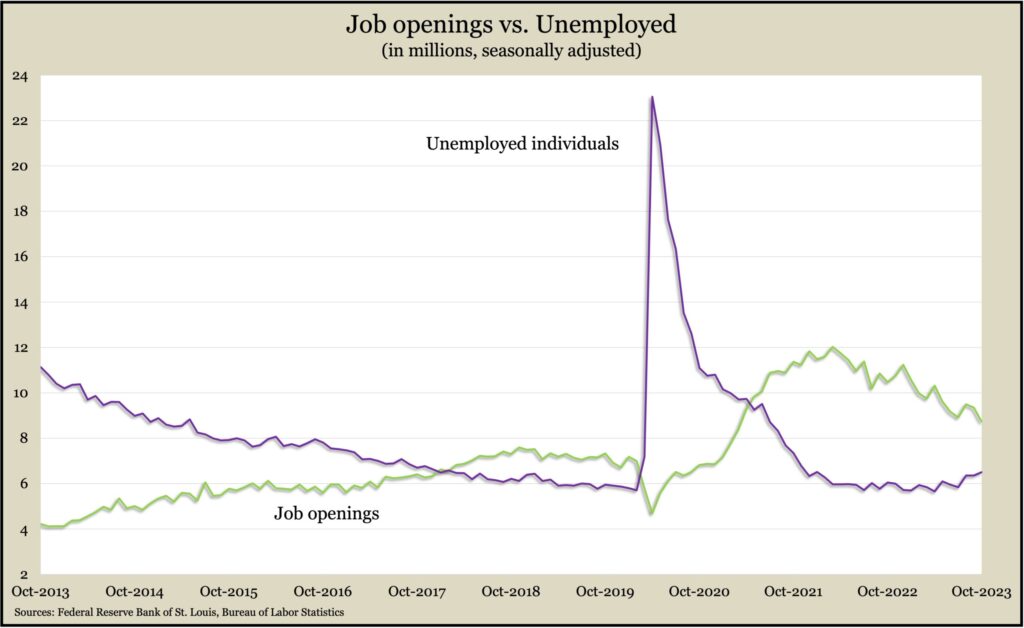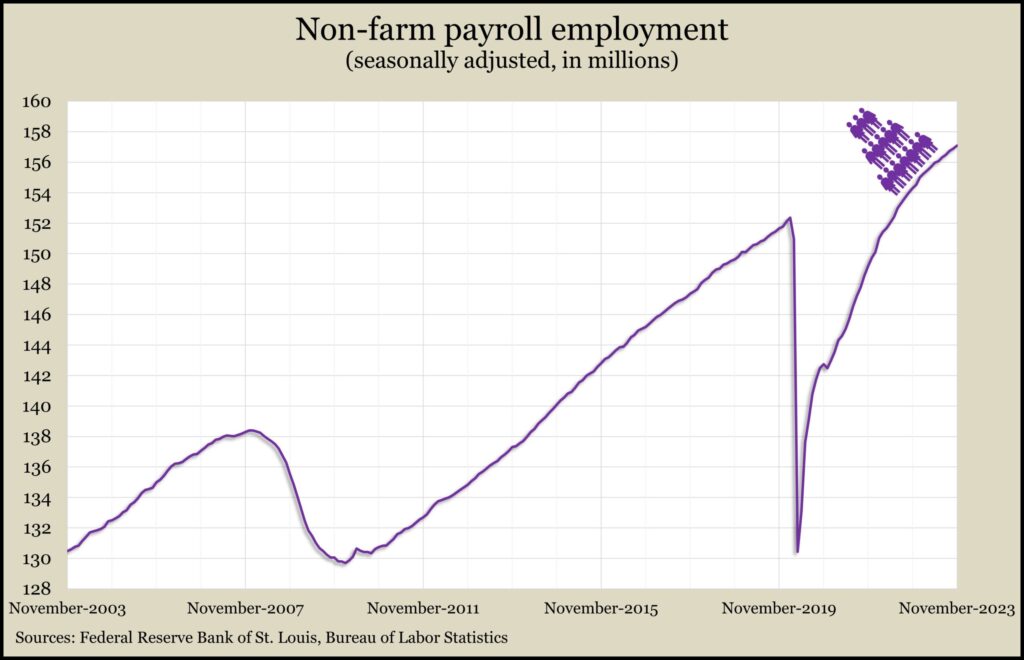Podcast: Play in new window | Download
Landaas & Company newsletter December edition now available.
Advisors on This Week’s Show
Kyle Tetting
Tom Pappenfus
Mike Hoelzl
(with Max Hoelzl, Joel Dresang, engineered by Jason Scuglik)
Week in Review (Dec. 4-8, 2023)
SIGNIFICANT ECONOMIC INDICATORS & REPORTS
Monday
The manufacturing sector showed broad weakness in October, with factory orders sinking 3.6% from September, down for the first time in three months. A plunge in commercial aircraft orders led the decline. Excluding transportation equipment, orders still fell 1.2% for the month, the Commerce Department reported. Total orders were up a scant 0.5% from the year before but up 1.2% without counting transportation. Orders for core capital goods, a measure of business investment, receded 0.3% from September and were up 1.8% from October 2022.
Tuesday
The service sector expanded in November, at a quicker pace and for the 11th month in a row, according to the Institute for Supply Management. The ISM service index suggested supplier deliveries are at their most efficient level since the end of the Great Recession. Supply bottlenecks were blamed for contributing to the highest inflation in 40 years amid the pandemic. The ISM said purchasing managers surveyed are most concerned about inflation, interest rates, geopolitical tensions and employment costs.
Employers’ appetite for new workers slumped in October to the lowest number of job openings since March 2021. The Bureau of Labor Statistics reported that employers posted 8.7 million openings, down from 9.4 million in September, though still 15% higher than the pre-pandemic peak. The balance between demand and the supply of unemployed job seekers reached its narrowest gap since July 2021. The rate of workers quitting their jobs – a sign of worker confidence – remained unchanged since July, the lowest in nearly three years.
Wednesday
The U.S. trade gap widened 5% to $64.7 billion in October. The value of exports shrank from September by 1%, led by automotive products. At the same time, imports rose 0.2%, led by computers. The Bureau of Economic Analysis said the trade deficit, which detracts from measures of economic output, grew 20% through the first 10 months of this year compared to the same period in 2022. In that time, exports grew 1.1% and imports declined 4%.
The Bureau of Labor Statistics said worker productivity rose at an annual rate of 5.2% in the third quarter, up from an earlier estimate of 4.7% and the fastest pace in three years. The annual growth rate for output rose 6.1% in the quarter while the pace of hours worked rose 0.9%. Measuring year over year, productivity advanced 2.4%. That compares to an average 1.5% year-to-year gain since the end of 2019, which is below the 2.1% average since 1947. The productivity report showed unit labor costs declining at a 1.2% annual pace during the quarter. Adjusted for inflation, labor costs rose at a 0.3% rate.
Thursday
The four-week moving average of initial unemployment claims rose for the first time in three weeks and the third time in five weeks. Still, the numbers continued to suggest an overall reluctance to let workers go. Data from the Labor Department showed the moving average for jobless applications is 40% below its 56-year average. Just under 1.9 million Americans claimed unemployment benefits in the latest week, up 0.3% from the week before, compared to 1.5 million the year before. According to the report, Wisconsin led the nation in new jobless claims in the week that ended Nov. 25. That often happens because of traditional employment accommodations certain Wisconsin businesses make around Thanksgiving and the deer hunting season.
The Federal Reserve Board reported a fourth consecutive rise in consumer credit card debt outstanding in October. It was the 30th time in 31 months the so-called revolving credit number advanced, though it was the slimmest of those increases, rising at an annual rate of 4.1%. Total consumer debt, including vehicle financing and student loans, rose at a 1.2% annual rate from September.
Friday
Employers continued to add jobs at a brisk pace in November, and the unemployment rate ticked down. The latest employment report, from the Bureau of Labor Statistics, showed 199,000 more jobs in November, below the 12-month average of 240,000, but the 35th consecutive gain. The average hourly wage rose 4% from November 2022, the smallest increase since June 2021. The seasonally adjusted unemployment rate fell to 3.7%, staying within a narrow band for nearly two years and hovering near the lowest levels since the 1960s.
Consumer sentiment has strengthened with broad expectations for lower inflation, the University of Michigan reported. A preliminary look at survey data for December showed the university’s sentiment index had risen 39% from its all-time low in June 2022, though it remained below its pre-pandemic level. Inflation expectations reached their lowest levels since 2021.
MARKET CLOSINGS FOR THE WEEK
- Nasdaq – 14404, up 99 points or 0.7%
- Standard & Poor’s 500 – 4604, up 10 points or 0.2%
- Dow Jones Industrial – 36248, up 2 points or 0.0%
- 10-year U.S. Treasury Note – 4.25%, up 0.02 point
Not a Landaas & Company client yet? Click here to learn more.
More information and insight from Money Talk
Money Talk Videos
Follow us on Twitter.

